D
Brief History of Subsea Oil Exploration1
The exploration history of the U.S. offshore oil and natural gas industry began in the Pacific Ocean more than 70 years ago (Figure D.1). As recently as 1947, no company had ever risked drilling beyond the sight of land (Figure D.2).
In 1896, as enterprising businessmen pursued California’s prolific Summerland oilfield all the way to the beach, the lure of offshore production enticed Henry L. Williams and his associates to build a pier 300 ft. out into the Pacific—and mount a standard cable-tool rig on it.
By 1897 this first offshore well was producing oil and 22 companies soon joined in the boom, constructing 14 more piers and over 400 wells within the next 5 years. The Summerland offshore field produced for 25 years—fueling the growth of California’s economy.
PIERS, PLATFORMS AND A PATENT
In 1894, Henry Williams drilled two wells on a California beach. He drilled another in 1895 with encouraging results. This led Williams and others to exploring for oil offshore the next year.
They constructed piers and drilled wells, leading to the realization that the Summerland oilfield extended offshore. This would be the first offshore field developed in the nation by drilling offshore wells from piers
—From Santa Barbara County records
___________________
1 NOTE: This appendix is excerpted from American Oil and Gas Historical Society, “Offshore Petroleum History,” http://aoghs.org/offshore-history/offshore-oil-history/, accessed November 13, 2017.
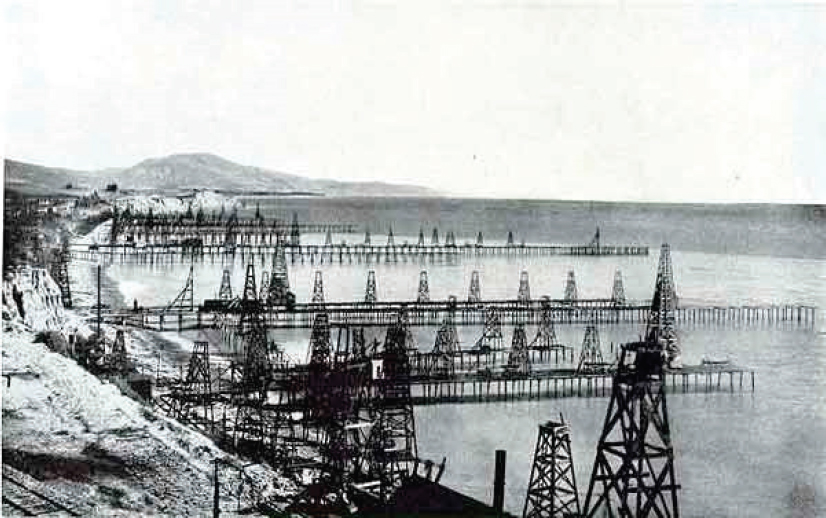
In 1911, Gulf Refining Company abandoned the use of piers. It drilled Ferry Lake No. 1 on Caddo Lake, Louisiana, using a fleet of tugboats, barges, and floating pile drivers. When the well came in at 450 barrels per day, Gulf constructed platforms every 600 ft. on each 10-acre lakebed site.
The Caddo Lake wells—completed over water without a pier connection to shore—have frequently been called America’s first true offshore drilling. A major petroleum company based in Pittsburgh, Pennsylvania drilled the first “over water” oil well in 1911, according to historian Bob Bowman of the East Texas Historical Association. “In the early l900s, 27-year-old Walter B. Pyron, of Blossom, Texas, a production foreman for Guffy Oil Company, noticed gas bubbles rising from Caddo Lake,” Bowman explains. “He and other Guffy employees rowed across the lake, lighting strings of the bubbles.”
“In early May, 1911, after months of hard work and battles with mosquitoes, alligators and moccasins, the Ferry Lake No. 1 was drilled to a depth of 2,185 and began producing 450 barrels of oil a day,” reports Bowman. Pyron convinced his superiors at Gulf Oil Corporation—the successor of Guffy Petroleum Company—to drill on the lake (Figure D.3).
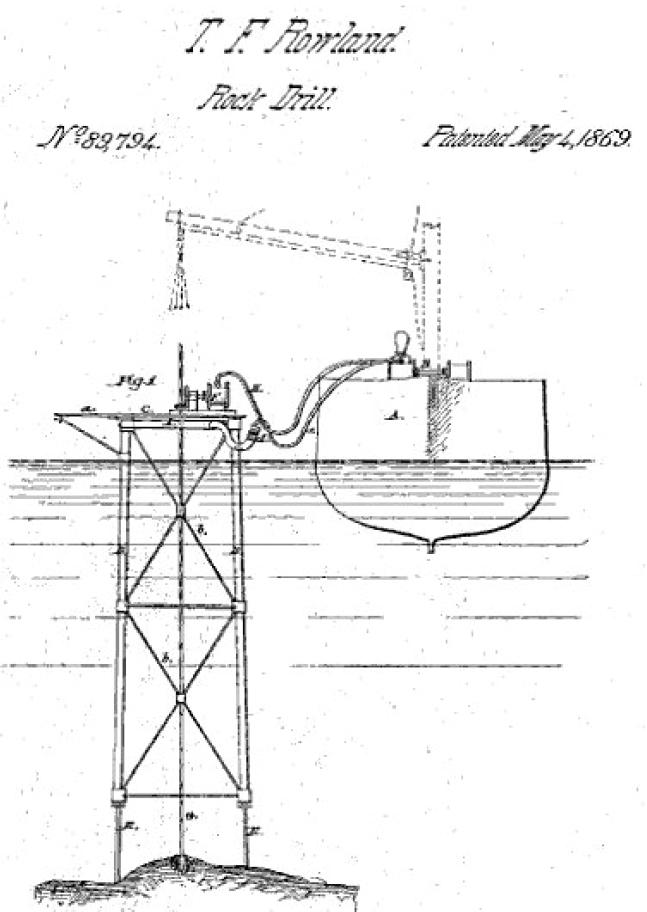
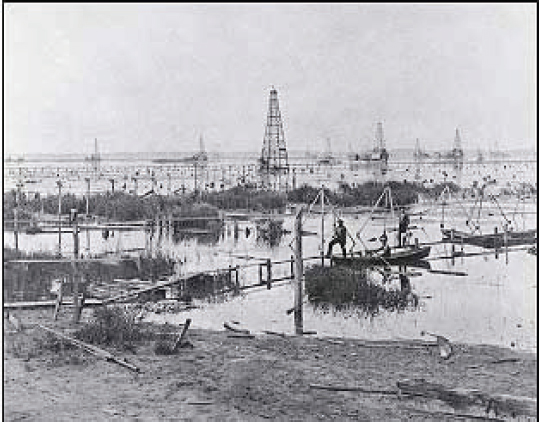
However, Ohio oil documents record hundreds of oil wells pumping far out into a lake—20 years before drillers ventured into the waters of Caddo Lake.
As early as 1891, the first submerged oil wells were drilled from platforms built on piles in Grand Lake St. Marys in Ohio, notes historian Judith L. Sneed in “The First Over Water Drilling: The Lost History of Ohio’s Grand Reservoir Oil Boom.” Even earlier, some historians say the true beginning of the modern offshore industry can be traced to an 1869 U.S. patent. Thomas Fitch Rowland of Greenpoint, New York, patented a “submarine drilling apparatus” on May 4, 1869. Rowland’s design included a fixed, working platform for drilling offshore to a depth of almost 50 ft. The anchored, four-legged tower—with telescoping legs “suitable hydraulic attachments or devices”—resembles modern offshore platforms (Figure D.4).
GULF OF MEXICO TECHNOLOGIES
In 1938, Pure Oil and Superior Oil Company built a freestanding drilling platform in the Gulf of Mexico—despite many logistics, engineering and communications challenges.
They hired a Houston engineering and construction company, Brown & Root Marine Operators to build a 320-ft. by 180-ft. freestanding wooden deck in 14 ft. of water about a mile offshore. The chosen drilling site was near Creole, Louisiana. Using onshore building criteria and intuition, the Creole platform was designed to withstand winds of 150 mph and constructed 15 ft. above the water. Three hundred treated yellow pine pilings were driven 14 ft. into the sandy bottom. The Superior-Pure State No. 1 well was successful—but was wiped off its pilings by a hurricane
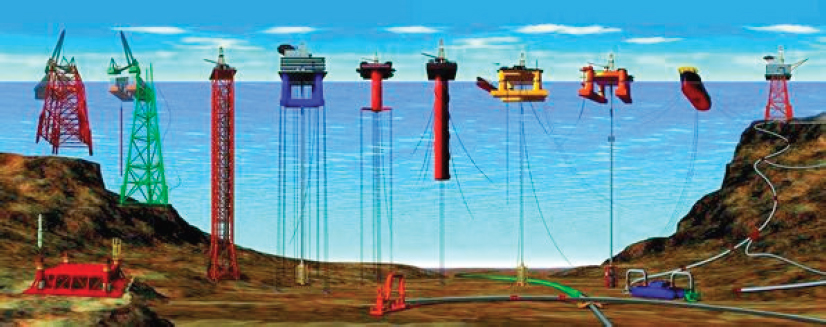
in 1940. The platform was quickly rebuilt and put back into production in the four million barrel field.
“It may be tentatively assumed that the Gulf of Mexico is a potential source of salt-dome oil,” reported geologist Orval Lester Brace in 1941. (See Figure D.5.) “Whether or not it will ever be economically feasible to explore these waters for the domes that must exist is a question for the future to answer.” Kerr-McGee dramatically answered the salt dome question in 1947 with an experimental offshore rig.
Not much equipment specifically designed for offshore drilling existed and exploration remained an extraordinarily speculative and risky business venture. An offshore dry hole could easily swallow the huge capital costs sunk into construction of a large, permanent rig platforms.
Nevertheless, Dean McGee of Kerr-McGee Oil Industries Inc. partnered with Phillips Petroleum and Stanolind Oil & Gas Co. to secure leases for exploratory wells in the Gulf of Mexico. They hired Brown & Root to build a freestanding platform 10 mi. out to sea.
KERR-MCGEE’S MIGHTY KERMAC NO. 16
“We decided to explore the areas where the really potential prolific production might be—salt domes—the good ones on land were gone, but we could move out in the shallow water and, in effect, get into a virgin area where we could find the real class-one type salt dome prospect,” McGee said.
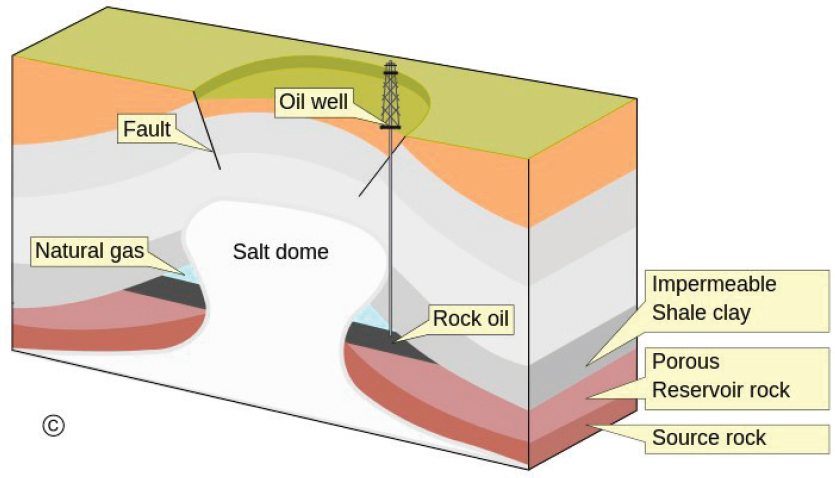
Vessels were needed to provide supplies, equipment, and crew quarters for the drilling site, 43 mi. southwest of Morgan City, Louisiana. The gradually sloping Gulf of Mexico reached only about 18-ft. deep at the drilling site.
A second platform would be built about 8 mi. from the first at Ship Shoal Block 28. Sixteen 24-inch pilings were sunk 104 ft. into the ocean floor to secure a 2,700 square foot wooden deck.
The Kermac No. 16 well stood in almost 20 ft. of water, 10 mi. at sea. The well was spudded on September 10, 1947. The biggest hurricane of the season arrived a week later—with winds of 140 mph. Kerr-McGee had $450,000 invested in the project. Both platforms were evacuated during the hurricane, but damage was minimal. Drilling promptly resumed. On November14, the Kermac No. 16 well came in at 40 barrels per hour. “Spectacular Gulf of Mexico Discovery. Possible 100-Million Barrel Field—10 Miles at Sea,” proclaimed the Oil & Gas Journal. Kermac No.16 would produce 1.4 million barrels of oil and 307 million cu. ft. of natural gas by 1984.
NEW OFFSHORE RECORDS
By the end of 1949, 11 oil and natural gas fields were found in the Gulf of Mexico with 44 exploratory wells, according to the National Ocean Industries Association, which notes that the industry continued to through the 1950s (Figure D.6). Modern offshore energy industry benefits come from the hard lessons
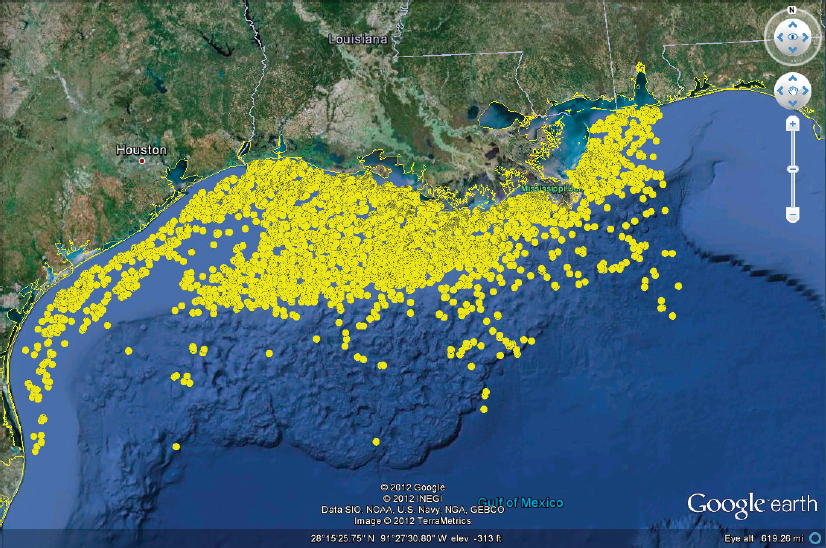
learned from 60 years of open water experience. Compared to the limits of just a few years ago, today’s achievements will no doubt pale in comparison to what the future of offshore exploration will bring. Revenue generated from the production of oil became the second-largest revenue generator for the country, after income taxes. But deeper wells mean higher costs—and far greater technical challenges.
The National Ocean Industries Association notes: “As the industry entered the last decade of the 20th century, advancing technology ensued. New depth records for drilling reached 7,625 ft. in the Gulf of Mexico.” In the North Sea, the Troll, a natural gas platform, stands in the North Sea in 1,000 ft. of water and is 1,500 ft. high (Figure D.7). According to a March 2013 article posted at Amusing Planet in 1996, the platform set the Guinness World Record for largest offshore gas platform. “The title now belongs to the Petronius Platform in the Gulf of Mexico, which stands 2,000 ft. above the ocean floor.”
Figure D.8 is a Bell Helicopter advertisement from 1954, courtesy of the Ocean Star Offshore Drilling Rig and Museum.
A flat area on an LST (from WW Two’s landing ship, tanks) anchored next to Humble Rig 28 served as landing pad for one of the first helicopters to be flown offshore. Today, helicopters are a common way for getting crews to and from offshore
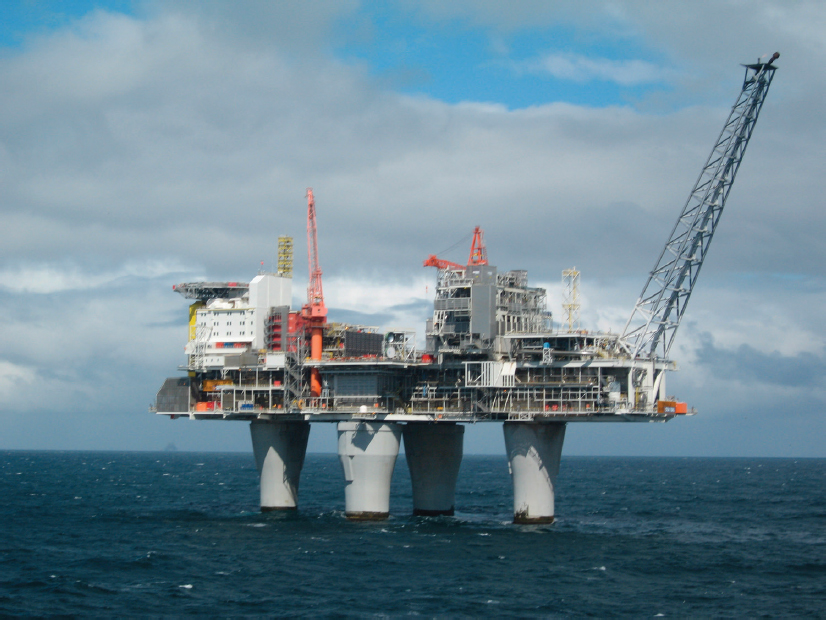
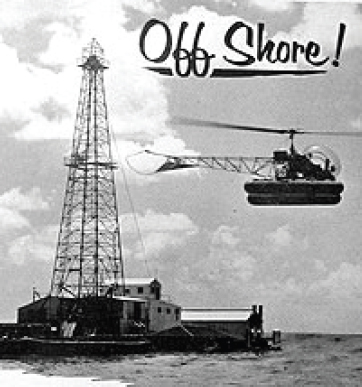
platforms. Constructed on land, as components of an offshore rig are completed, they are shipped to the drilling location. Sometimes assembly takes place as the rig is being transported to its intended destination.
In addition, more scientists now recognize the role of petroleum platforms as artificial marine habitats. Whether placed as an artificial reef or a working (producing petroleum) structure, studies have been found rigs to increase the algae and invertebrates that attract—and significantly increase—numbers and species of fish.
On November 11, 2007, a mile and a half underwater, a petroleum company’s remote control submersible camera captured a rarely seen Magnapinna squid (Figure D.9). The brief video, obtained by National Geographic News, shows the alien-like squid loiter above the seafloor in the Gulf of Mexico. The clip—from Shell Oil Company’s Perdido production site—marks the first sighting of a Magnapinna or “big fin” squid near oil development. Marine biologists now partner with petroleum companies.
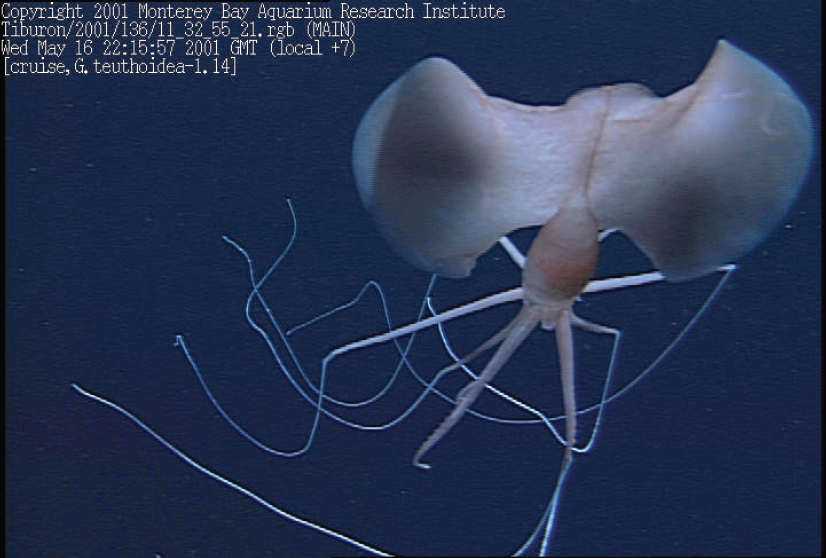
OFFSHORE OIL AND GAS RESOURCES
Gulf of Mexico federal offshore oil and natural gas production accounts for 23 percent of total U.S. crude oil production and federal offshore natural gas production in the Gulf accounts for 7 percent of total U.S. dry production, according to the Energy Information Administration. More than 40 percent of total U.S. petroleum refining capacity is located along the Gulf coast, as well as 30 percent of total U.S. natural gas processing plant capacity. To meet increasing U.S. demand while addressing environmental concerns, new technologies have resulted in drilling rigs capable of drilling 250 mi. offshore to ocean depths exceeding 10,000 ft. At stake are an additional 19 billion barrels of oil and another 86 trillion cu. ft. of gas. Fear of oil spills and heated environmental debates restrict access to many potential areas.
More than 5,000 offshore oil and natural gas platforms operate in the Gulf of Mexico around the clock, seven-days a week. It is the largest artificial reef system in the world.
According to the National Academy of Sciences, more than 60 percent of all oil found in seawater is not from wells, but from natural seepage (the largest emitting 1,000 barrels of oil a week); 32 percent comes from shipping and run-off from land. Four percent can be attributed to tanker spills. However, near Santa Barbara, Calif., offshore drilling’s worst environmental disaster occurred in 1969 when an undersea well blew out. The calamity quickly brought industry changes that have protected the offshore environment ever since. Between 1980 and 1999, about 7.4 billion barrels of oil were produced in federal waters, says the U.S. Coast Guard. Less than a thousandth of one percent spilled—less than the natural seepage of oil from the sea floor.










